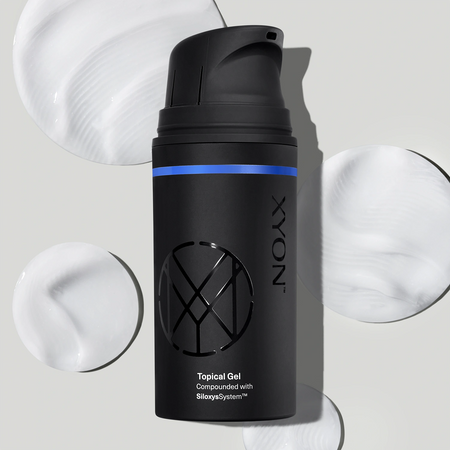Pattern hair loss can’t be solved overnight. But there are effective medications such as oral and topical finasteride, that can start to work within a matter of months to deliver denser, healthier hair and stop thinning in its tracks. In this article, we’ll answer frequently asked questions about how long it takes finasteride to work for hair loss and the other health indication for which it’s indicated, benign prostatic hyperplasia.
How long does topical finasteride take to work?
With most hair loss treatments, patience is needed before seeing results. Topical finasteride is no exception. In general, you’ll need to consistently use your treatment for 3-6 months to see a visible response. Within this 3-6 month timeline, there are certain things you can watch out for that can indicate that the treatment is working.
During the first month of starting treatment, you may notice that you’re actually losing more hair. Finasteride shedding is more common than you think and can catch patients off guard. Thankfully, it’s usually temporary and considered a sign that the medication is working as the hair growth cycles of older hairs are being reset. Older growth is shed to allow new growth to occur. This type of shedding should resolve within a few months, but let your doctor know if shedding persists for longer.
At the 6 month point is when most patients will start to see evidence of their commitment to treatment. By now, hair follicles have adjusted to a new growth cycle. It’s important to understand that certain areas of the scalp may respond better to finasteride treatment than others and that this is normal. Additionally, for some men, there may be less hair growth than expected, but the key is that new hair loss is minimized.
Remember that hair loss treatment has two goals: slow or halt the progression of hair loss and encourage new growth. This is why it’s so important to begin treatment early. Clinical data show that the maximum benefit of finasteride is typically achieved after 1 to 2 years of treatment (Shin et al., 2018)
In just a few months, see real results with a clinically proven treatment for hair loss.


Start your journey to stopping your hair loss
How long does oral finasteride take to work?
The good news is that you can expect oral and topical finasteride to work based on the same timeline. This means that if you choose to take oral finasteride, you would still be waiting approximately 3-6 months to truly begin seeing results. Shedding is still a possibility, but like topical finasteride, it should be self-limiting and go away without additional intervention after a few months.
Can I speed up finasteride results?
While faster results with finasteride aren’t necessarily possible, there are some things you can do to optimize hair growth while taking finasteride. These include combining finasteride and minoxidil treatment or using hair care products containing ingredients such as saw palmetto, a natural DHT blocker. There is some data that suggests that low-level laser therapy (LLLT) and platelet-rich plasma therapy may help boost the efficacy of finasteride for hair loss, but these modalities have limited medical evidence at this time (Munck et al., 2014 and Alves and Grimalt, 2018).
How long does finasteride take to work for BPH?
You may be aware that finasteride is also FDA approved to treat a separate medical condition linked to DHT, called benign prostatic hyperplasia (BPH). In the case of BPH, the purpose of finasteride is to help shrink the prostate gland by lowering levels of DHT, which directly influence the growth of prostate cells. Reduced urinary flow rate is a common symptom of an enlarged prostate and finasteride treatment can help reduce the mass of the gland to restore flow rates.
The usual oral treatment for BPH is finasteride 5 mg taken once a day. One study found that if this dosing is followed consistently, it can lower DHT within 2 weeks, as evidenced by improvements in urinary symptoms. At the 6 and 12 month time intervals, measured urinary flow rates were significantly improved compared to baseline. Additionally, the most dramatic reductions in prostate size were observed in the first 6 months of treatment (Gormley et al., 1992).
What this data tells us is that similarly to hair loss, men with BPH will likely need to persist with their prescribed finasteride treatment for at least 6 months before determining whether it has been effective. If you’re uncertain whether finasteride is working for you, you should consult your prescribing doctor to discuss.
How long before finasteride starts working: Takeaway
For both pattern hair loss and benign prostatic hyperplasia, finasteride starts to have an effect on DHT levels within weeks of starting the medication, but results are likely to take longer before becoming visible. This is because it takes time for hair follicles to adjust to a new growth cycle in the case of hair loss and prostate tissues to shrink in the case of BPH.
Clinical studies of the efficacy of finasteride for both of these indications point out that adherence to treatment is needed to maintain results. This is why it’s so critical that once finasteride treatment is started, that you try your best not to miss any doses. If you have any concerns about the dosing of your treatment or why you’re not seeing results, please talk to your prescribing doctor.




